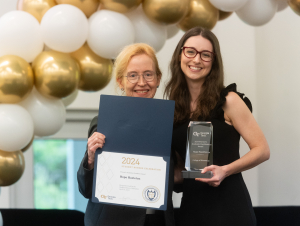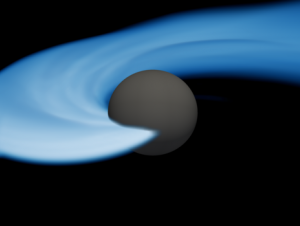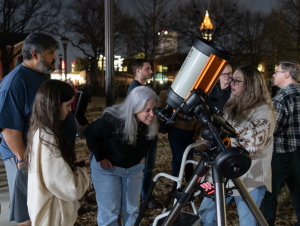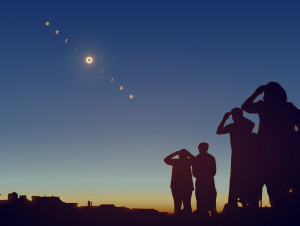Latest News
Students from all six College of Sciences schools were recognized for excellence at this year's celebration.
Shortly after the start of the fourth LIGO-Virgo-KAGRA (LVK) observing run, the LIGO Livingston detector observed a remarkable gravitational-wave signal from the collision of what is most likely a neutron star with an unknown compact object — one that's 2.5 to 4.5 times the mass of the Sun.
This week, 50 students from Georgia Tech’s Astronomy Club will travel to Missouri to view the solar eclipse on April 8. Georgia isn’t in the path of totality — which occurs when the moon fully covers the sun — but Missouri is, and club members want to be there to experience the rare celestial event. While viewing the eclipse is the organization’s biggest adventure of the year, it is just one of many events the club hosts every month. The group is a place for hobbyist astronomers and physics students to connect over their love of the solar system and the mysteries within it.
As the April 8 solar eclipse approaches, millions of people anticipate participating in the wonder of this celestial event. Yet, for those with visual impairments, traditional methods of observing such phenomena may present limitations. Fortunately, resources from the team of Tech’s Sonification Lab offer an inclusive approach.
Events
Physics of Living Systems (PoLS) Seminar -Prof. Yinglong Miao
Physics of Living Systems (PoLS) Seminar |Prof. Yinglong Miao| Chapel Hill|Univ. of North Carolina| - Prof. JC Gumbart
Earth Day Sustainable Org Fair and Celebration
Join us to celebrate sustainability efforts on campus in honor of Earth Day!
School of Physics Seminar - Professor Jianming Wen
Advancing Quantum Information Science and Technologies with Narrowband Entangled-Photon Generation in Neutral Atoms
Advancing Quantum Information Science and Technologies with Narrowband Entangled-Photon Generation in Neutral Atoms
Quantum information science stands at a transformative crossroads, poised to revolutionize diverse fields such as computing, cryptography, communication, networks, metrology, sensing, and imaging.
Gravitational-Wave Open Data Workshop Study Hub
(The last day to sign up is April 15, 2024.) This study hub is geared towards local participants (at all levels) who would like to interact with public gravitational-wave data in some capacity, for educational or research purposes.
School of Physics – Physics & Startup Seminar - Professor Christopher Monroe (Duke University and formerly IonQ, Inc)
Quantum Computing Meets Wall Street
GT Observatory Public Night: April 2024
A monthly occurrence of the GT Observatory's Public Night open to all who are interested in viewing celestial objects through our many telescopes here on campus.
Experts in the News
It’s been 10 years since the Air Force Research Laboratory, or AFRL, successfully launched the astronomy outreach program called Aloha Explorations at the Air Force Maui Optical and Supercomputing site, or AMOS, in Maui, Hawaii. This STEM outreach project uses an 11-inch Celestron telescope, also known as the Aloha Telescope, to provide students in grades K-12 the ability to view live images from their classrooms and remotely control the telescope via an internet connection. The idea for this project originated from Dr. James Sowell, an astronomer and observatory director at the School of Physics. (This story also appeared at Los Alamos Daily Post and Defense Visual Information Distribution Service.)
Air Force Research Laboratory 2024-04-04T00:00:00-04:00Georgia Tech students associated with the Astronomy Club are traveling to Missouri in order to be in the path of totality for the April 8 solar eclipse. The path of totality is the prime spot for viewing the moon travel between the Earth and the Sun. For the eclipse viewing trip, the Club plans to bring along astrophotography gear, an 8-inch Celestron telescope with a solar filter, and other equipment for members to use. (The Atlanta Journal-Constitution also covered this story.)
11 Alive 2024-04-01T00:00:00-04:00Odd things can happen when a wave meets a boundary. In the ocean, tsunami waves that are hardly noticeable in deep water can become quite large at the continental shelf and shore, as the waves slow and their mass moves upward. In a recent study led by School of Physics Dunn Family Professor Daniel Goldman and published in the journal Physical Review Letters, scientists have shown that a floating, symmetric oscillating robot will experience forces when it comes close to a boundary. These forces can be used for self-propulsion without the need for more typical mechanisms such as a propeller.
Tech Xplore 2024-03-09T00:00:00-05:00The way muscles work changes when a person goes from slow, even movements to rapid, unsteady movements. Anyone who’s pulled a muscle after a sudden motion knows that. What we don’t know is exactly how muscle function changes when dynamic movement is introduced. A new NSF-funded project co-led by Simon Sponberg, Dunn Family Associate Professor in the School of Physics and School of Biological Sciences, will examine dynamic muscle function of humans and animals with the goal of creating improved physical therapy and rehabilitation programs and mobility assistance devices. That translates to more humans who can move with less pain.
Northern Arizona University 2024-03-04T00:00:00-05:00Are our bodies solid or liquid? This question begins the exploration of a study led by Zeb Rocklin, an assistant professor in the School of Physics at Georgia Tech, that blurs the lines between solid and liquid states by examining materials that exhibit properties of both. The study, titled 'Rigidity percolation in a random tensegrity via analytic graph theory,' published in the Proceedings of the National Academy of Sciences (PNAS), introduces a novel approach to understanding the behavior of deformable solids through the incorporation of cable-like elements, offering insights with significant implications for biology, engineering, and nanotechnology.
BNN 2024-02-29T00:00:00-05:00Researchers at the Georgia Institute of Technology, working with a team from China’s Tianjin University, claim to have developed the first functional semiconductor from graphene, a single-layer carbon structure renowned for its robust bonds. Led by Walter De Heer, Regents' Professor in the School of Physics, the study published in Nature details a graphene semiconductor compatible with standard microelectronic processing methods, a fundamental requirement for any viable alternative to silicon.
Electronic Engineer Times Europe 2024-02-28T00:00:00-05:00





